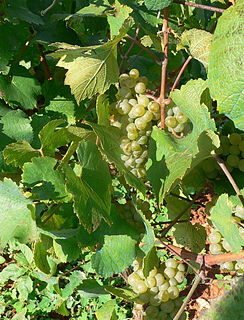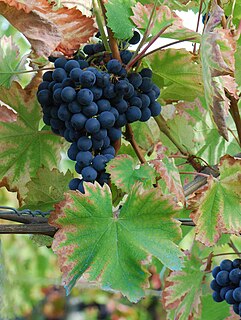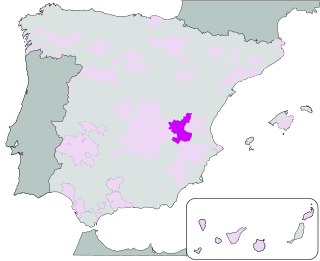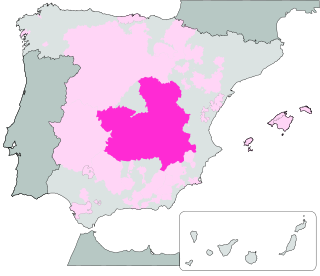Related Research Articles

Syrah, also known as Shiraz, is a dark-skinned grape variety grown throughout the world and used primarily to produce red wine. In 1999, Syrah was found to be the offspring of two obscure grapes from southeastern France, Dureza and Mondeuse Blanche. Syrah should not be confused with Petite Sirah, a cross of Syrah with Peloursin dating from 1880.

Malvasia is a group of wine grape varieties grown historically in the Mediterranean region, Balearic Islands, Canary Islands and the island of Madeira, but now grown in many of the winemaking regions of the world. In the past, the names Malvasia, Malvazia, and Malmsey have been used interchangeably for Malvasia-based wines; however, in modern oenology, "Malmsey" is now used almost exclusively for a sweet variety of Madeira wine made from the Malvasia grape. Grape varieties in this family include Malvasia bianca, Malvasia di Schierano, Malvasia negra, Malvasia nera, Malvasia nera di Brindisi, Malvasia di Candia aromatica, Malvasia odorosissima, and a number of other varieties.

Carignan is a red grape variety of Spanish origin that is more commonly found in French wine but is widely planted throughout the western Mediterranean and around the globe. Along with Aramon, it was considered one of the main grapes responsible for France's wine lake and was a substantial producer in jug wine production in California's Central Valley but in recent years, it has been reborn as a flagship wine for many cellars in the south of France as well as in Catalonia.

Tempranillo is a black grape variety widely grown to make full-bodied red wines in its native Spain. Its name is the diminutive of the Spanish temprano ("early"), a reference to the fact that it ripens several weeks earlier than most Spanish red grapes. Tempranillo has been grown on the Iberian Peninsula since the time of Phoenician settlements. It is the main grape used in Rioja, and is often referred to as Spain's noble grape. The grape has been planted throughout the globe's wine regions.

Macabeo, also called Viura or Macabeu, is a white variety of wine grape.

Mourvèdre is a red wine grape variety grown in many regions around the world including the Rhône and Provence regions of France, the Valencia and Jumilla denominaciones de origen of Spain, as well as the Balearic Islands, California and Washington and the Australian regions of South Australia and New South Wales, as well as South Africa. In addition to making red varietal wines, Mourvèdre is a prominent component in "GSM" blends. The variety is also used to make rosé and port-style fortified wines.

Spanish wine includes red, white, and sparkling wines produced throughout the country. Located on the Iberian Peninsula, Spain has over 1.2 million hectares planted in wine grapes, making it the most widely planted wine-producing nation but the second largest producer of wine in the world, behind Italy and ahead of France, and the United States. This is due, in part, to the very low yields and wide spacing of the old vines planted on the dry, infertile soil found in some of the Spanish wine regions. The country is ninth in worldwide consumption with Spaniards drinking, on average, 21.6 litres per person a year. The country has an abundance of native grape varieties, with over 400 varieties planted throughout Spain though 88 percent of the country's wine production is from only 20 grapes — including the reds Tempranillo, Bobal, Garnacha, and Monastrell; the whites Albariño, Airén, Verdejo, Palomino, and Macabeo; and the three Cava grapes Parellada, Xarel·lo, and Macabeo.

Alternative wine closures are substitute closures used in the wine industry for sealing wine bottles in place of traditional cork closures. The emergence of these alternatives has grown in response to quality control efforts by winemakers to protect against "cork taint" caused by the presence of the chemical trichloroanisole (TCA).

Muscat Blanc à Petits Grains is a white wine grape of Greek origin that is a member of the Muscat family of Vitis vinifera. Its name comes from its characteristic small berry size and tight clusters. It is known under a variety of local names such as Moscato bianco, Muscat blanc, Muscat Canelli, Muscat de Frontignan, Muscat de Lunel, Muscat d'Alsace, Muskateller, Moscatel de Grano Menudo, Moscatel rosé and Sárgamuskotály.

Grenache blanc is a variety of white wine grape that is related to the red grape Grenache. It is mostly found in Rhône wine blends and in northeast Spain. Its wines are characterized by high alcohol and low acidity, with citrus and or herbaceous notes. Its vigor can lead to overproduction and flabbiness. However, if yields are controlled, it can contribute flavor and length to blends, particularly with Roussanne. Since the 1980s, it has been the fifth most widely planted white wine grape in France after Ugni blanc, Chardonnay, Semillon and Sauvignon blanc.

Manchuela is a Spanish Denominación de Origen Protegida (DOP) for wines located in the historical Manchuela comarca, in the east of the provinces of Albacete and Cuenca between the valleys of the Rivers Júcar and Cabriel. It was originally part of a much larger La Mancha DOP and became a separate DOP in 2004. It is surrounded on three sides by other DOPs: La Mancha to the west, Utiel-Requena to the east and Jumilla to the south.

The history of Rioja wine reflects a long and varied winemaking tradition in the Spanish region of La Rioja, starting with the first Phoenician settlers in 11th century BC. As with many of Europe's most well known wine regions, the Ancient Romans founded many of the Rioja vineyards. Throughout the Middle Ages, pilgrims to the shrine of St. James at Santiago de Compostela passed through the region and carried back with them the reputation of wines from the area. The phylloxera epidemic of the late 19th century was a major catalyst in the expansion and modernization of the Rioja wine industry, with the devastation the French wine industry both opening up the French wine market and bringing an influx of French investment into the region. Today, together with Sherry, Rioja is the most internationally recognized of all Spanish wines.

The history of Sherry is closely linked with that of Spanish wine production, particularly the political fortunes of the Cádiz region, where it originated with the early Phoenician settlement of the Iberian Peninsula. The triangular region between the towns of Jerez de la Frontera, El Puerto de Santa María, and Sanlúcar de Barrameda still marks the limits of the modern denominación. One of the world's oldest wines, its considerable evolution has been marked by the influence of many of the world's greatest empires and civilizations: the Phoenicians, Greeks, Romans, Moors, Spanish and British. Today, while Sherry does not enjoy the level of popularity it once did, it remains one of the wine world's most unusual and historical expressions.

Ancient Rome played a pivotal role in the history of wine. The earliest influences on the viticulture of the Italian peninsula can be traced to ancient Greeks and the Etruscans. The rise of the Roman Empire saw both technological advances in and burgeoning awareness of winemaking, which spread to all parts of the empire. Rome's influence has had a profound effect on the histories of today's major winemaking regions in France, Germany, Italy, Portugal and Spain.
Albillo or Albillo Real is a white Spanish wine grape variety planted primarily in the Ribera del Duero region, and also in Madrid, Ávila and Galicia. The grape has mostly neutral flavors with a light perfume aroma. It has a high glycerol index which confers smoothness to the wines.

Cayetana blanca, also known as Cayetana or Jaén, is a white Spanish wine grape. It is grown mainly in the south of Spain, especially in Extremadura and in the Jerez region where it is distilled for use in brandy production.

Castilla is a Spanish geographical indication for Vino de la Tierra wines located in the autonomous region of Castilla-La Mancha. Vino de la Tierra is one step below the mainstream Denominación de Origen indication on the Spanish wine quality ladder.

Villanueva del Pardillo is a municipality of the Community of Madrid, Spain.

Omer Pardillo Cid is a Grammy, Latin Grammy and Emmy-winning producer and talent manager. He began his career in 1992 in the Media Relations department at RMM Records in New York City. At RMM, he handled publicity for celebrities, such as Celia Cruz, Marc Anthony and Tito Puente.
Pardina can refer to:
References
- ↑ J. Robinson Jancis Robinson's Wine Course Third Edition pg 117 Abbeville Press 2003 ISBN 0-7892-0883-0